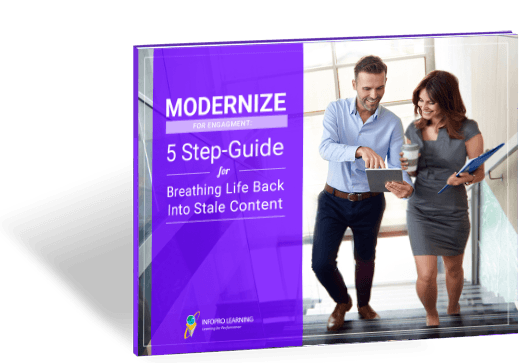How To Analyze Your eLearning Content For Modernization
If you’re not sure if you need to modernize your content, I’d suggest reading my article on why every company needs a modernization strategy. If you are considering modernizing eLearning content, but not quite sure if it’s right for you, then I also suggest reading 5 Questions to Ask Before Modernizing eLearning. After you're done with those, read on for how to analyze your eLearning content for modernization.
Analyze your eLearning content inventory in 3 ways:
1. Categorize Content
Categorize content based upon the changes needed to modernize. There are three changes to content that are a part of modernization:
A. Technology Changes
Technology changes could be simply making your courses more engaging by making them mobile compatible. Over 50% of online traffic is on mobile devices, while only 2% of training content is mobile compatible.
Larger technological changes require determining content’s shelf life:
- Short Shelf Life.
Content with a short shelf must be changed frequently, and would be best developed with a rapid altering tool or an appropriate Learning Content Management system. The content can then be quickly edited and reused. - Long Shelf Life.
To protect from technological compatibility issues, content with a long shelf life would best be stored in a system and player agnostic format.
B. Content Changes
Content inaccuracies are a key factor in employees losing interest in your training, but finding all content changes can be very time-consuming. Not only for developers, but for multiple stakeholders, such as reviewers, subject matter experts, legal, marketing, IT, and other teams.
Our rule of thumb is if you can live with the content, don’t touch it. We recommend only reviewing content that is older than two years unless you are in an industry where content changes rapidly.
C. Design Changes
Depending on how the original content was made, design changes may or may not be a big task. You know an engaging design when you see it. Often just viewing the splash page of a course will tell you all you need to know.
Factors to review for design:
- Mobile, tablet compatibility.
- Up-to-date feel.
- The learning experience.
- Lack of appeal or engagement.
None are more important or critical than the others, but the difficulty of achieving each will vary from organization to organization.
2. Evaluate Learner Demographics
Moving from course categories, you also need to identify important learner characteristics, such as:
A. Generation
Baby Boomers, GenX, Millennials, GenZ, more than likely, you have more than two generations working in your company. Appealing to all of them is critical. Now I don’t believe that all people in a generation are the same and that there is one-size-fits-all approach to each, especially when it comes to learning content, but learner age is important. The broad characteristics of each generation are correct often enough to warrant attention.
B. Workplace
Whether an office cubicle, on the road, or on the floor of the factory, the workplace will determine the best size of learning content chunks, the best media for delivery, and the best instructional strategy.
For example, while a mobile based small learning video will appeal to the road warriors of the sales force, a shoulder to shoulder coaching strategy makes more sense to workers on an assembly line in the factory.
C. Business Characteristics
Business characteristics impact learning. Turnover rate and regulatory constraints are two important business traits that heavily affect learning:
- Turnover Rate.
How often employees leave directly affects learning and development. For example, the customer service industry has a very high turnover rate, so the total time for training is very limited, and it is 100% skill based. In this industry you don’t have time for frills. You need to-the-point training that onboards quickly and effectively. - Regulatory Constraints.
Do your employees need to know multiple governmental and organizational regulations. For example, if you have to comply with federal regulations, those specific regulations have to a part of training, including certification and tracking.
3. Create An Update Plan
The last part of the analysis phase is to create plans for updating content. To create long-term and short-term plans, categorize content based upon when it was created:
A. 1-3 Years Old
Learning courses created within the last three years only need to be updated for content inaccuracies, which naturally occur as your company pivots and reacts to market changes.
B. 3-5 Years Old
Content created 3-5 years ago is also fairly recent, but because technology changes rapidly, most likely uses old technology. Check the content for compatibility issues with new technology and design standards. Use engine, design, and template customization to quickly modernize from older to a new technology.
C. >5 Years Old
In our experience, any content that is more than five years old is typically not useful and should be retired and archived. But if you do have content that was created that long ago, is still relevant, can be repurposed with new design and technology, and it makes sense to do so, by all means, make it a part of your modernization project. Even then though, I would advise you to wait until later to update, when you have a larger budget (See category 3 content)
Modernize Programs Increase ROI and Engagement
With significant investments in content development, companies need to search for ways to repurpose content across various learning programs. Not only will this increase the ROI, but it will also help increase engagement by modernizing the look and feel of courses to match the changes in learner demographics.
Download our eBook Modernize for Engagement to see how in 5 steps (This step, analyze, is the third step) we modernize content for better engagement and breathe life back into stale content.









